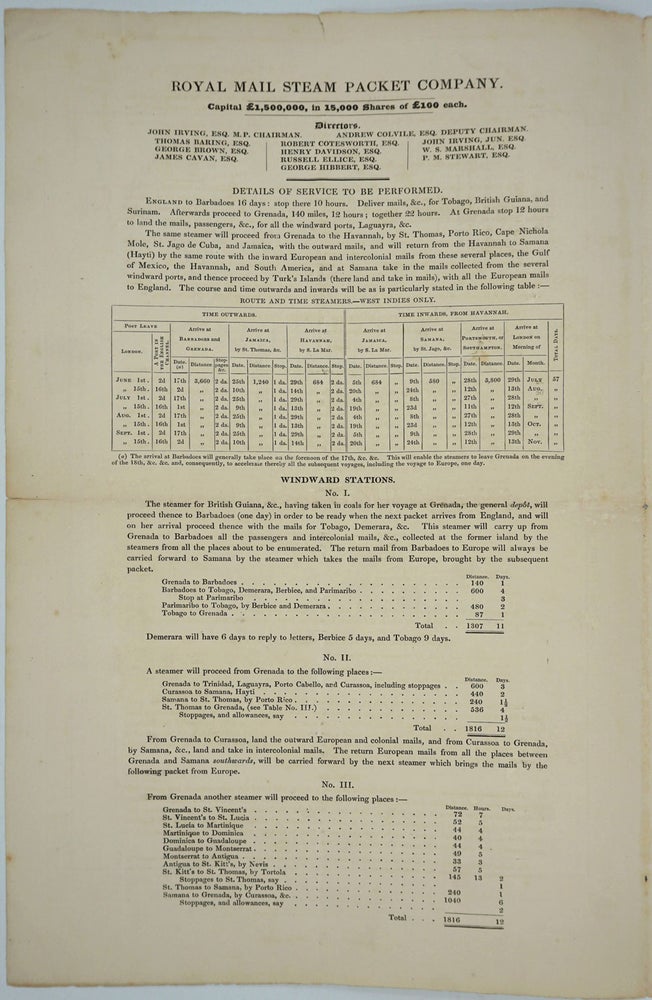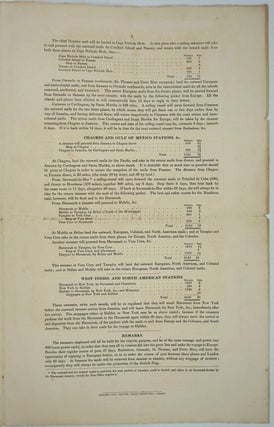Royal Mail Steam Packet Company - A 4 page prospectus for service between England and the British West Indies.
London: Richard Clay, Printer, Bread Street Hill, 1839. First printing. Ephemera. Scarce, separately published folio broadside/ prospectus with an Arrowsmith map of the Royal Mail's proposed routes in the West Indies. This prospectus was produced in the founding year of the Royal Mail Steam Packet Company. The shipping line went on to become the largest in the world. The map appears as the cover and is titled
"Chart of the West Indies, the Isthmus of America and lines of proposed Steam Mail Communication. Drawn by James Mc Queen, 1839".
This prospectus records capital of L1,500,000, and John Irving as the Chairman. "Routes of Service to be Performed" and a table titled "Route and Time Steamers - West Indies Only", show a proposed departure date of June 1, with stops at Barbadoes, Grenada, Jamaica, and Havannah and return to London on 29th July, for a total of 57 days.
The company was established just following the emancipation of slaves in the West Indies (1834), and MacQueen hoped that the resulting instability and loss of income from the region might be mitigated through commerce. MacQueen had a larger vision for the company: that it would be profitable not just for shareholders but for also for Britain, as a way to maintain some control over their old colonies.
The RMSPC, which became the largest shipping line in the world in the 1920s, was founded in 1839 by James MacQueen (1778-1870). The West India Committee, an association in London of merchants and planters, supported the formation of the company, whose first chairman was John Irving, a merchant banker. James MacQueen was appointed General Superintendent of Affairs.
From its founding the RMSPC aimed to be at the forefront of British naval supremacy. In 1840 it signed a contract with the Admiralty and agreed to provide a fleet of 14 steam ships which would carry the mail twice a month to Barbados in the West Indies from Southampton or Falmouth. This contract with the Admiralty meant that the Royal Navy was very involved in the operation of the ships of the line.
The start of service was planned for December of 1841; 14 large steam vessels and 3 small sailing ships were commissioned. Over the next few years the service was extended several times: in 1846 service to the west coast of South America was added (served by the Pacific Steam Navigation Co) over the Isthmus of Panama, and in 1850, when a monthly service was established to Brazil. The RMSPC also tried throughout the 1850s and 60s to gain a foothold in the Australasian trade via Panama, but did not succeed.
MacQueen published a book in 1838, "A General Plan for a Mail Communication by Steam, Between Great Britain and the Eastern and Western Parts of the World..". In the preface, he thanks John Arrowsmith for his aid in publishing the map MacQueen has drawn.
The prospectus text consists of 3 sections describing the routes within the West Indies and the pertinent distances and times, titled "Windward Stations"; "Chagres and Gulf of Mexico Stations, & c.", and "West Indies, and North American Stations", which includes New York and Halifax via Havannah, Savannah and Charleston. The "Remarks" section states, "The steamers employed will all be built for the express purpose, and be of the same tonnage and power (say 400 horse power each), in order that they may all in rotation fall into the great line and make the voyage to Europe".
The map extends from Florida down through the Caribbean and Central America to the "Mouth of the Amazon or Maranon" on the eastern coast of South America. Three cross Atlantic routes from Britain are shown between Samana Hayti, St. Thomas and Barbados to Portsmouth and Falmouth. Inter island routes connect the islands, including Cuba. The US ports shown include Savannah, Mobile and New Orleans. "J. Arrowsmith" and "London, John Arrowsmith, 1839" are printed from left to right below the border.
The Royal Museums Greenwich has no record of holding this prospectus, despite holding a collection of records of the Royal Mail Steam Packet Company, including the royal charter and renewals, minute books of directors' meetings and general meetings, letterbooks, correspondence, financial documents and log books. The map itself is recorded as a single sheet in the "Catalogue of Books in the Portsmouth Athenaeum," p. 191.
4 folio sheets, with the prospectus at pp2 & 3, and the cover the Arrowsmith map of the proposed routes. Folded in half, with the map "Chart of the West Indies...", as the cover. Not located in OCLC. Contemporary fold, tanned along fold line. Very good condition. Item #24211
Price: $1,250.00




